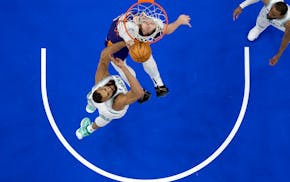Forsaking early-morning sleep, members of the U-17 USA bandy team fought through subzero temperatures during practice Sunday.
"Do we have to go back outside?" one team member quipped during a warming up break.
They did. They had the U17 World Championships, which run from Wednesday to Friday in Roseville, to prepare for.
So, the girls went back outside where the only reminder of warmth was the flicker of digital flames on the scoreboard.
They chased around neon pink bandy balls while practicing with a Swedish boys team.
"My toes were really, really cold," said Annika Duryea, a forward from Richfield, adding that she planned to use foot warmers. "My feet are probably the biggest problem just because you can't fit five layers of socks inside your skates but you can definitely layer."
She'll need the foot warmers, as the World Championships, which will feature Sweden, Finland and Russia and the United States, will be played at the Guidant John Rose Oval, the only full-size outdoor bandy rink in the country.
The team is made up of 14- to 16-year-olds from metro-area schools, including Holy Angels, Minnetonka, Richfield and Blake. All play hockey as well, including some who competed in the girls' hockey state tournament and weren't able to join the team until this week.
On its surface, bandy looks like hockey's cousin — players skate around a rink trying to shoot an object into a net with a stick.
But the size and shape of the ball, stick and surface differentiate the two sports.
"There's not much that's similar besides skating on ice because the whole play is different," defenseman Finn Larson said.
Hockey has more starts of stops while in bandy, players are constantly moving. Bandy has less contact, which makes it more of a game of speed.
"For hockey it's more about your wrist motion, but for bandy, you just want it to be one quick motion and shooting in hockey it's more precise and you need to have a very accurate shot because the net is so small," Duryea said.
Positions in bandy are more like soccer than hockey. Larson, who plays soccer, said she adopted her soccer position of playing defense rather than playing forward, like she does in hockey.
Members of the team still are finding their way, as the group was assembled in late January and had less than 10 practices before the tournament as players competed in high school hockey.
Many of the players were introduced to the sport during a 2012 cultural exchange trip to Sweden.
Team manager Paul Larson helped corral others.
"We knew in order to be relatively competitive against the teams coming here, we have to have really good skaters, so we recruited the really good skaters," Paul Larson, Finn's father, said.
The United States is competing in the world championships for the first time. Once the Federation of International Bandy awarded it the bid, the team had to start fundraising.
It was aided in part by a successful GoFundMe campaign, which raised more than $5,000 to help provide food, sleeping arrangements and ground transportation for the visitors.
"Basically we said to all of our families, if you want to participate, if you value what we're doing here, we need your effort … to spread the word," Paul Larson said.
With the championships set to begin Wednesday, the players are excited to finally tackle tournament play.
"I know in the beginning we were scared [that] all the other teams have been practicing and they try out and they're going to be really good, but I think we definitely have grown in the short amount of time that we've been practicing together, so I'm really optimistic about it," Duryea said.
With not much of a chance to compete locally, the team is embracing the opportunity it has.
"What we're trying to instill in the girls is that our measurement of success is improvement every game and enjoying the experience," Paul Larson said.
Betsy Helfand is a University of Minnesota student reporter on assignment for the Star Tribune.

Reusse: How bad are the White Sox? They made Twins look good.
NFL draft has been on tour for a decade and the next stop is Detroit, giving it a shot in spotlight

Souhan: Wolves fans made Game 1 special. Now bring on Game 2.

Will Wolves show best-in-the-NBA defensive form in Game 2?

